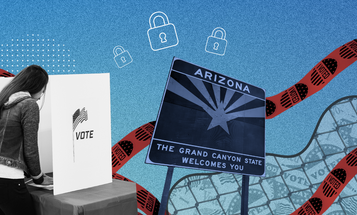
Ohio Ruling on Voter Purging is a Setback for Voting Rights
In a blow for voting rights today, an Ohio federal court ruled that the state does not have to provide relief to allow purged voters to participate in this November’s mid-term elections.
Ohio elections officials use a procedure known as the Supplemental Process to identify voters who may have moved. Under this process, voters who have not voted in 2 years are sent an official mailing asking for address confirmation. If the voter does not respond or vote in the next 4 years, they are purged from the rolls.
Despite our arguments that the official mailing form was defective in several ways, the judge found the form legal in all respects but one, and declined to order the reinstatement of the purged voters. The court did order the state in the future to use a form that is correct in that one respect: specifically, that the form include information on how to re-register for people who move out of state.
“We are gratified that the court ruled that Ohio’s notice has for many years been out of compliance with the National Voter Registration Act in one way, but unfortunately, the court failed to recognize the multiple other ways in which Ohio had violated federal law, and it left Ohio voters who have been wrongfully purged or are set to be wrongfully purged after the November election with no relief or option to cast a ballot that will count,” said Stuart Naifeh, senior counsel at Demos. “Moreover, this decision comes after the voter registration deadline has passed and just as early voting is beginning, when voters and our clients can no longer take matters into their own hands to correct the Secretary’s violation of federal law.”
“Even though the judge ordered the state to use a specifically corrected form of notice, he didn’t provide any relief for purged voters—who were purged because of notices that were also deficient in other important ways. This decision, affecting real people and coming this close to the midterm elections, is particularly concerning. Due to a temporary remedy in place while this case was pending, 7,798 voters who were purged, but still otherwise eligible, were able to vote. This decision means that similar voters will now be disenfranchised, unless they somehow learned in time that they had been purged, and re-registered,” said Freda Levenson, Legal Director, ACLU of Ohio.
"This decision is a major disservice to communities of color in Ohio who want to exercise their right to vote,” said Andre Washington, president, Ohio A. Philip Randolph Institute (APRI). “Today is a disappointing day for democracy."
“People are being blatantly locked out of the democratic process, particularly poor and homeless individuals,” Chris Knestrick, Executive Director of the Northeast Ohio Coalition for the Homeless (NEOCH), said. “To cast a ballot just became increasingly difficult. We are deeply disappointed.”
Background
In 2016, Demos and the ACLU of Ohio filed suit on behalf of Ohio APRI, NEOCH, and Ohio resident Larry Harmon, challenging voter purges conducted pursuant to Ohio’s Supplemental Process. They alleged that the Process violated a federal law, known as the National Voter Registration Act of 1993 (NVRA), in 2 ways. The first claim alleged that the State’s use of non-voting to target people for removal from the rolls violated federal law. The second claim alleged that the notice sent to voters did not meet the specifications set forth in the NVRA.
The Sixth Circuit Court ruled in favor of the Plaintiffs on both issues in September 2016. After this decision, Ohio appealed the Plaintiffs’ first claim to the U.S. Supreme Court. On June 11, 2018, in Husted v. APRI, the United States Supreme Court ruled that states could use a registrant’s lack of voting activity to initiate a removal process under the NVRA.
After the Supreme Court’s decision, litigation continued over the Plaintiffs’ second claim—namely, whether Ohio’s notification mailings complied with the NVRA. Plaintiffs argued that Ohio did not abide by the law because the state’s mailings failed to provide a deadline to respond to avoid being purged; did not properly inform potential voters that they would be removed from the rolls if they did not respond; and did not inform citizens what they needed to do to vote if they moved out of the state. Every notice Ohio sent from 1995 through 2016 failed to meet these requirements in one or more ways.
On September 14, Plaintiffs asked that any eligible voter, purged after receiving a flawed mailing, be allowed to cast a ballot in the November midterm elections as well as future elections. The Plaintiffs also requested that no registrant who had received such a notice, but who was not yet purged, be removed without first receiving an NVRA-compliant notice.
###



